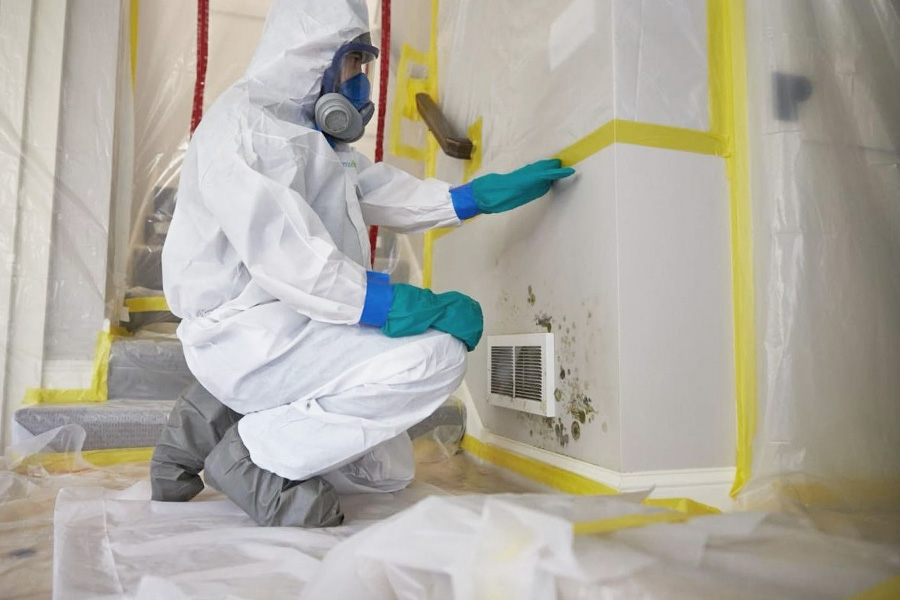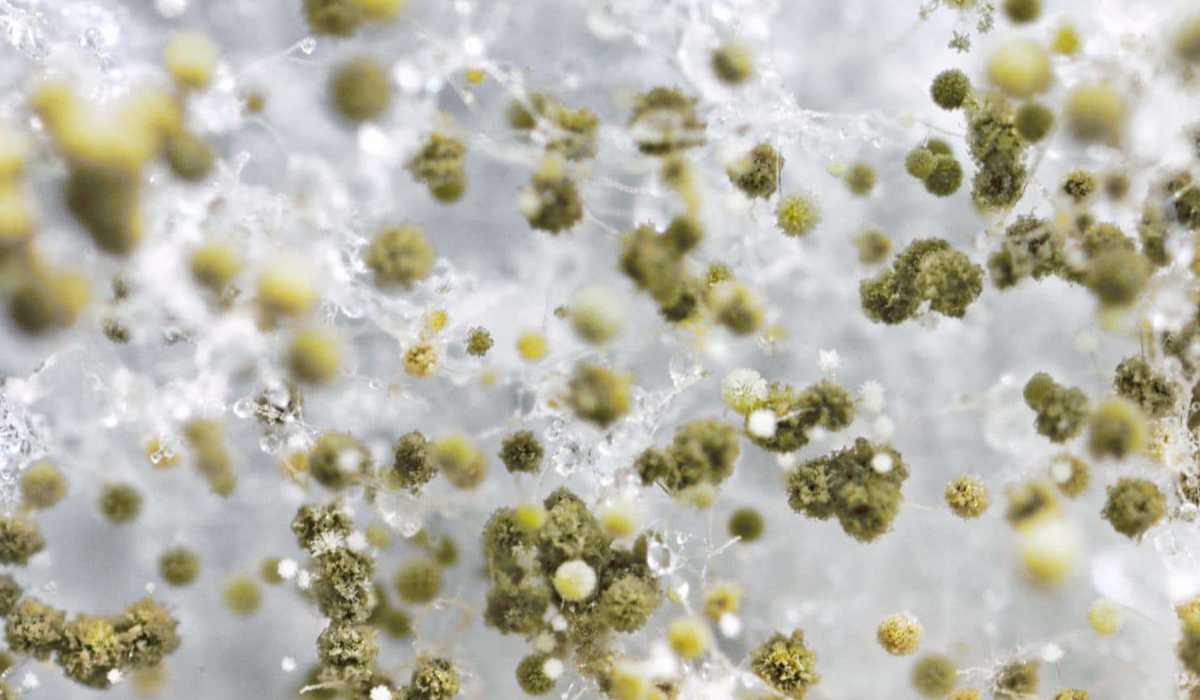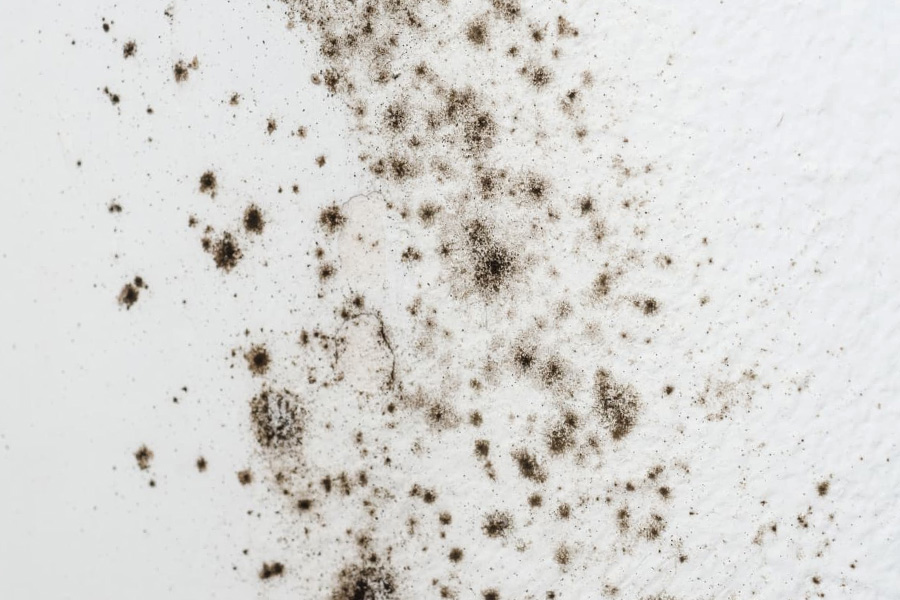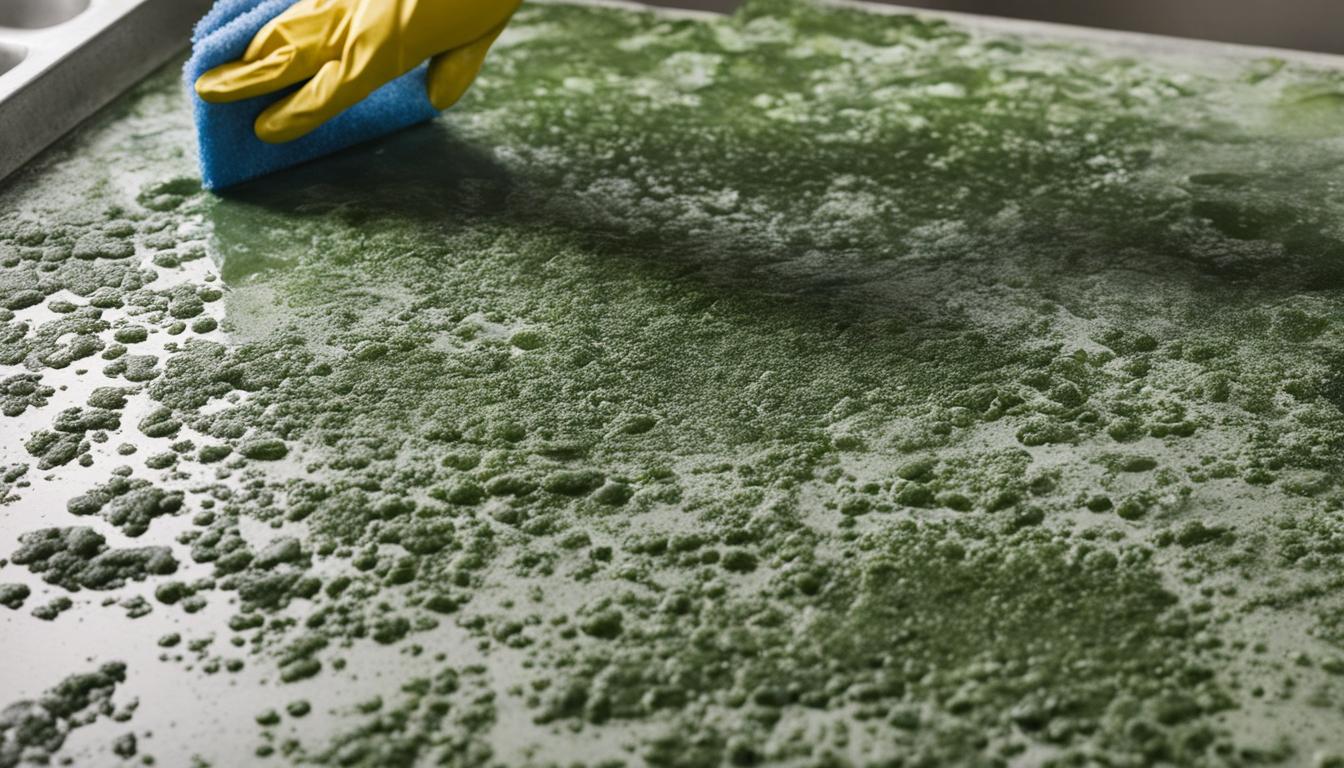
Vinegar for Mold: Effective Cleaning & Remediation
If you’re looking for a natural and effective solution for mold removal, vinegar might be the answer. Not only is vinegar readily available and affordable, but it also has antimicrobial properties that make it an ideal cleaning agent for mold. In this article, we’ll explore the ins and outs of using vinegar for mold remediation, including how to use it, how effective it is, and its benefits compared to other mold cleaners.
Key Takeaways:
- Vinegar is a natural and affordable option for mold cleaning and remediation.
- Vinegar has antimicrobial properties that make it effective against mold.
- Vinegar can be used for different types of mold, including black mold and mildew.
- Vinegar can also be used for mold prevention.
- Proper safety precautions must be taken when using vinegar for mold removal.
Understanding Mold Growth and Risks
Mold is a fungus that grows in warm, moist environments. It can thrive on a variety of surfaces, including walls, ceilings, and fabrics. Mold growth can pose several risks to both property and human health.
The most significant risk associated with mold growth is structural damage to buildings. Mold can weaken wood, drywall, and other building materials, leading to costly repairs. Additionally, mold growth can trigger asthma attacks and other respiratory problems. This is especially true for individuals with pre-existing health conditions or weakened immune systems. Young children and the elderly are also particularly susceptible to these health risks.
It’s important to address mold growth promptly to prevent these issues from developing. Not only can it save you money in the long run, but it can also protect the health of you and your loved ones.
The Four Stages of Mold Growth
Mold growth occurs in four stages: mold spores, germination and colonization, growth, and sporulation.
| Stage | Description |
|---|---|
| Mold spores | The initial stage of mold growth begins when mold spores are introduced to a surface. |
| Germination and colonization | The mold spores begin to germinate and colonize the surface they land on, creating a small patch of visible mold. |
| Growth | If left untreated, the mold will continue to grow and spread, covering a larger area of the surface and releasing more spores into the air. |
| Sporulation | The final stage of mold growth is sporulation, where the mold begins to release large amounts of spores into the air, further exacerbating respiratory risks and property damage. |
Understanding the stages of mold growth can help you identify mold early and take steps to remove it before it becomes a larger problem.
Introduction to Vinegar as a Mold Cleaner
Vinegar is a versatile and effective natural solution for removing mold from surfaces. Its acidic properties make it an excellent mold cleaner, capable of breaking down mold spores and inhibiting further growth.
Compared to other harsh chemical cleaners, vinegar is a safe and eco-friendly option for individuals looking to clean without compromising their health or the environment. Its low toxicity and biodegradable nature make it an ideal choice for those who prioritize sustainability.
When using vinegar as a mold cleaner, it’s important to keep in mind that while it is an effective solution for mold remediation, it may not be suitable for all types of mold. Additionally, vinegar should be used with caution on surfaces that may be sensitive to acid, such as natural stone or marble.
How Vinegar Works as a Mold Cleaner
Vinegar works by breaking down the proteins in mold spores, effectively killing them and preventing further growth. Due to its acidic nature, vinegar is particularly effective on non-porous surfaces, such as tile or glass. When applied to moldy areas, vinegar penetrates the surface and goes to work on the mold spores beneath.
While vinegar is effective at removing visible mold growth, it may not be sufficient for addressing deeper mold problems, such as those found beneath drywall or in other concealed areas. In these cases, it may be necessary to enlist the help of a professional mold remediation service.
Overall, vinegar is an excellent natural solution for mold remediation, particularly for environmentally conscious individuals and those seeking a safer alternative to harsh chemical cleaners. Understanding how to use vinegar effectively can help you keep your home or business free of mold and promote a healthier environment.
Using Vinegar for Mold Removal
If you’re looking for a natural and effective way to remove mold, vinegar is a great option. Not only is vinegar safe and eco-friendly, but it’s also readily available and affordable. Follow these steps for using vinegar to remove mold from surfaces:
- Prepare a vinegar solution: Mix equal parts white vinegar and water in a spray bottle.
- Spray the affected area: Liberally spray the vinegar solution onto the moldy surface, ensuring the area is completely saturated. Don’t rinse the area after spraying.
- Allow the vinegar solution to work: Let the vinegar solution sit on the moldy surface for at least an hour, or until the area is completely dry. The vinegar will penetrate the mold and kill it at its roots.
- Clean the surface: Wipe the surface with a damp cloth to remove any remaining mold or vinegar residue.
- Repeat as necessary: For stubborn or persistent mold, repeat the process until the mold is completely removed.
Best Techniques for Applying Vinegar
The effectiveness of using vinegar for mold removal depends on how thoroughly the solution is applied. For best results:
- Ensure the vinegar solution completely saturates the moldy surface, allowing it to penetrate the mold and kill it at the roots.
- Consider using a spray bottle or sponge to apply the vinegar solution evenly.
- Prevent the vinegar solution from dripping or running by covering the surface with a cloth or baking soda paste.
After applying the vinegar solution, be patient and allow it to sit and penetrate the mold. Do not rinse or wipe the area immediately after spraying.
Vinegar for Black Mold Remediation
Black mold is a hazardous and stubborn type of mold that requires immediate action to avoid potential health risks. Vinegar is a natural and effective way to combat black mold and prevent its growth.
The acidity of vinegar helps to break down the mold’s DNA structure, preventing it from spreading and killing off existing spores.
When using vinegar for black mold remediation, it’s essential to take precautions to ensure safety. Wear protective gear such as gloves, goggles, and a face mask to avoid exposure to mold spores and vinegar fumes.
Before applying vinegar to black mold, remove any visible mold growth using a cloth or brush. Mix one part vinegar with one part water and apply the solution to the affected area using a spray bottle or cloth.
Allow the solution to sit on the surface for an hour, then rinse with water and dry thoroughly. Repeat the process until the black mold is no longer visible.
Vinegar vs. Bleach for Black Mold Remediation
While bleach is commonly used for mold remediation, it’s not the most effective solution for black mold. Bleach can only remove surface mold, leaving roots and spores intact, leading to recurring growth. In comparison, vinegar can remove mold while providing preventative measures against further growth and health risks.
Preventing Mold with Vinegar
To prevent mold growth, it’s important to keep your home clean, dry, and well-ventilated. But even with the best efforts, mold can still appear, especially in damp areas like bathrooms, kitchens, and basements. This is where vinegar comes in as a natural and effective mold prevention tool.
Vinegar has antimicrobial properties that can help inhibit mold growth and prevent it from spreading. Plus, compared to chemical-based cleaners, vinegar is a safer and eco-friendly option for mold prevention. Using vinegar regularly can help keep your home mold-free and create a healthier living environment for you and your family.
To use vinegar for mold prevention, simply mix equal parts vinegar and water in a spray bottle and apply it to areas prone to mold growth, such as shower walls and curtains, sinks, and windowsills. Let it sit for a few minutes before wiping it away with a clean cloth. This will not only remove any mold that has already begun to grow, but it will also help prevent the spores from returning.
It’s important to note that while vinegar is generally safe, it can be harmful if ingested or inhaled in large quantities. Always use vinegar in a well-ventilated area, and keep it out of reach of children and pets. Additionally, vinegar should not be used on certain surfaces, such as stone or marble, as it can erode the surface.
Best Practices for Using Vinegar as a Mold Prevention Tool
| DOs | Use vinegar regularly in damp areas prone to mold growth |
|---|---|
| Mix vinegar and water in a spray bottle for easy application | |
| Let the vinegar solution sit for a few minutes before wiping it away | |
| Ensure proper ventilation when using vinegar | |
| Store vinegar in a cool, dry place away from sunlight | |
| DON’Ts | Use vinegar on surfaces that can be damaged by acid, such as stone or marble |
Follow these best practices to effectively use vinegar as a mold prevention tool and keep your home mold-free.
Vinegar for Mildew Removal
Mildew is a common type of mold that’s often found in damp areas such as bathrooms, kitchens, and basements. Using vinegar is an effective way to remove mildew without using harsh chemicals. Vinegar has a high acidity level that helps to break down the fungal growth, making it easier to wipe away.
To use vinegar for mildew removal, mix equal parts water and white vinegar in a spray bottle. Spray the solution onto the affected area and let it sit for 30 minutes. Then, scrub the area with a brush or sponge and rinse thoroughly with water. For tougher mildew stains, use undiluted vinegar.
After removing mildew with vinegar, it’s essential to take steps to prevent its recurrence. Keep the area dry and well-ventilated, repair any leaks or water damage promptly, and use a dehumidifier if necessary. Regularly cleaning surfaces with a vinegar solution can also help prevent mildew growth.
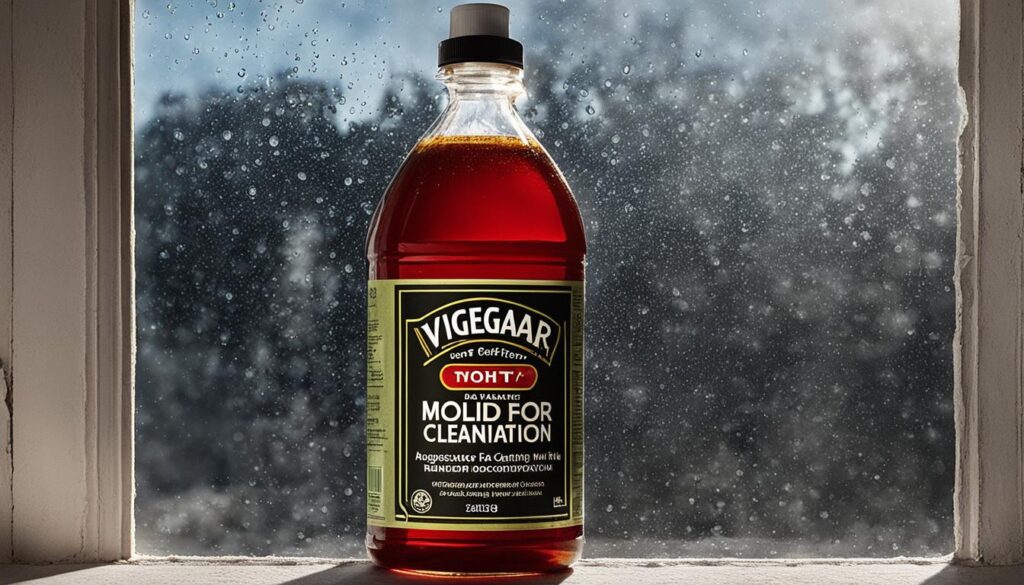
Mildew Removal with Vinegar: Benefits and Limitations
Vinegar is a natural and affordable alternative to chemical-based mildew cleaners. It’s also safer for use on surfaces such as fabrics and carpets since it doesn’t contain harsh chemicals that can damage these materials.
While vinegar can effectively remove mildew, it may not work as well on large or stubborn mildew stains. In these cases, it’s best to seek professional help or use a commercial mildew cleaner. Additionally, vinegar has a strong odor that some people find unpleasant, so proper ventilation is crucial when using it for mildew removal.
Addressing Mold and Mildew on Different Surfaces
Mold and mildew can thrive on various surfaces, making it crucial to know how to address them effectively. Using vinegar as a natural cleaner is an excellent option for removing mold and mildew from surfaces around your home. However, different surfaces require different cleaning techniques and dilution ratios to achieve the best results.
For non-porous surfaces like tiles, glass, and bathtubs, you can use undiluted vinegar or a vinegar-water solution in a spray bottle. Let the mixture sit for several minutes before wiping the surface with a clean cloth. For porous surfaces like walls and ceilings, use a stronger vinegar solution of 1:1 or 2:1 vinegar and water. Apply the solution using a sponge or cloth, then rinse with water and dry the area thoroughly.
Carpets and fabrics also require a different approach to remove mold and mildew. Mix one cup of white vinegar with two cups of water and apply the solution to the affected area with a clean cloth or spray bottle. Blot the area thoroughly and avoid saturating the fabric with the solution to prevent water damage. You can also add vinegar to your laundry for moldy clothes or towels.
It’s crucial to understand that while vinegar is safe for most surfaces, it can damage some materials such as marble or granite. Always test your cleaning solution on a small, inconspicuous area before applying it to the entire surface.
Mold and Mildew on Different Surfaces: A Comparative Guide
| Surface Type | Vinegar Dilution Ratio | Cleaning Technique |
|---|---|---|
| Bathtubs and Tiles | Undiluted or Vinegar-Water Solution (1:1) | Spray and Let Sit, then Wipe with Cloth |
| Porous Surfaces (Walls, Ceilings) | Vinegar-Water Solution (1:1 or 2:1) | Apply with Sponge or Cloth, Rinse with Water and Dry Thoroughly |
| Carpets and Fabrics | Vinegar-Water Solution (1:2) | Apply with Clean Cloth or Spray Bottle, then Blot Thoroughly |
As you can see, different surfaces require varying degrees of concentration and technique when it comes to using vinegar as a natural mold and mildew remover. Always follow instructions carefully and take extra precautions when dealing with toxic black mold. Regular cleaning and prevention are also necessary to keep mold and mildew at bay.
Vinegar as a Safer Alternative to Harsh Chemicals
Many commercial mold cleaners contain toxic chemicals that can be harmful to both people and the environment. Unlike these harsh chemicals, vinegar is a safer and more eco-friendly alternative that can provide effective and natural cleaning for mold and mildew.
Vinegar is a natural acid that can eliminate up to 82% of different types of mold while remaining safe for use around pets and children. Additionally, vinegar is biodegradable and does not contain any harmful chemicals, making it better for the environment.
Using vinegar reduces the potential risks associated with exposure to toxic chemicals, which can cause damage to the respiratory system and other vital organs.
When compared to chemical-based cleaners, vinegar’s effectiveness may vary based on the severity of mold growth. However, vinegar remains an excellent option for moderate to mild cases of mold.
The Benefits of Using Vinegar Instead of Harsh Chemicals:
| Benefits of Vinegar: | Benefits of Harsh Chemicals: |
|---|---|
| Vinegar is safe for use around pets and children. | Chemical-based cleaners may contain toxic substances harmful to pets and children. |
| Vinegar is a more affordable option compared to commercial cleaners. | Chemical-based cleaners can be more expensive. |
| Vinegar has a far less impact on the environment than harsh chemicals. | Harsh chemicals may cause health issues to arise amongst wildlife and aquatic ecosystems. |
| Vinegar is a versatile and popular household item that most people likely already have at home. | Harsh chemical cleaners may require additional purchasing or equipment to be effective. |
Vinegar provides a safer and more affordable cleaning solution for mold and mildew, while also mitigating environmental damage caused by glass cleaning products.
Tips for Using Vinegar Safely and Effectively
To get the most out of using vinegar for mold cleaning, it is essential to follow safety guidelines. Though vinegar is relatively safe to use, it is still a strong acid that can cause skin irritation and respiratory problems if used improperly. Here are some tips for using vinegar safely and effectively:
- Ventilate the area: Open windows and doors or use a fan to increase ventilation in the room. This helps to dilute the strong, lingering vinegar smell and minimize respiratory discomfort.
- Wear protective gear: Wear gloves, a mask, and eye protection to avoid respiratory irritation and skin burns resulting from direct contact with vinegar solution.
- Use the right concentration: Different types of vinegar may have different concentrations, and each mold species may react differently to the vinegar solution. Always check the correct vinegar concentration for the specific type of mold and surface being cleaned to achieve optimal results.
- Store vinegar properly: Store vinegar in a cool, dry place, away from direct sunlight, heat, and moisture. Using expired or spoiled vinegar can be ineffective and may even cause more harm than good.
- Do a spot test: Before using vinegar on a larger surface, it is advisable to test a small, inconspicuous area first to ensure that the vinegar solution will not discolor, damage, or harm the surface or material.
By using vinegar safely and effectively, it is possible to eliminate mold without causing harm to yourself or the environment.
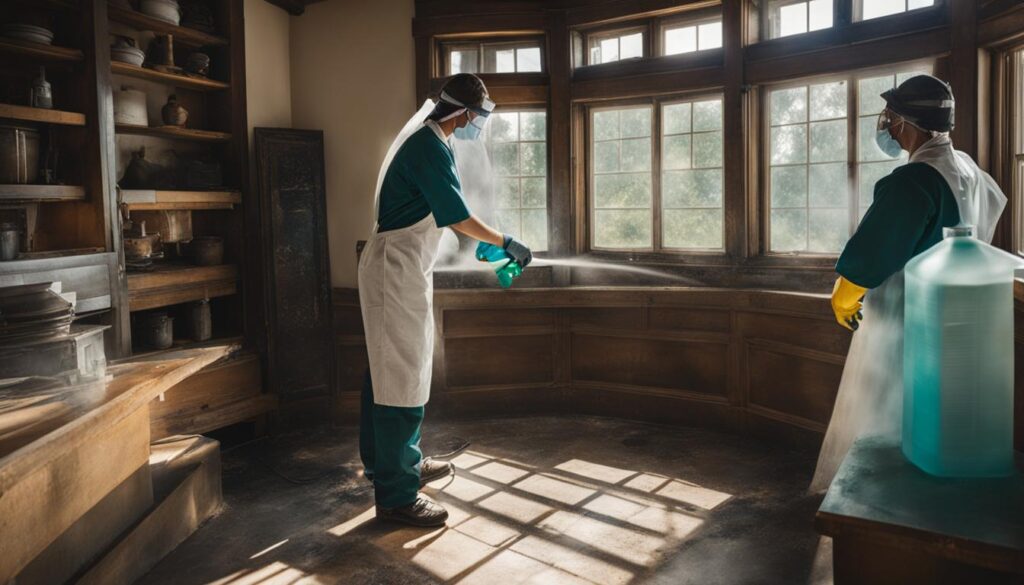
Vinegar and Mold: Common Myths Debunked
Many misconceptions around using vinegar for mold have spread over the years. This section aims to dispel some of the most common vinegar and mold myths and provide accurate information.
- Vinegar is not effective for Black Mold Removal: This is a prevalent myth. While vinegar is not the most effective solution for a full-scale black mold infestation, it can still slow down the growth of black mold. As we discussed in Section 5, vinegar can help eliminate black mold, but it may not eradicate the problem entirely.
- Vinegar kills all mold types: This is another widespread myth. While vinegar is effective at killing many mold species, it is not a panacea for all types of mold. For example, some mold species that grow inside walls or other hidden areas may not be eliminated with vinegar.
- Vinegar prevents mold regrowth: Although vinegar is an effective mold prevention tool, it cannot guarantee that mold will not reappear. Mold can grow under various conditions, which is why it’s essential to address the root causes of mold growth.
- Vinegar is a toxic mold cleaner: Vinegar is a natural and safe alternative to harsh chemicals, which is why it’s a popular option for mold removal. It’s crucial, however, to keep in mind that vinegar should still handle with care and proper safety measures in place.
Now that we have debunked these myths let’s remember that vinegar helps remove mold in a safe, eco-friendly way. In the next section, we will discuss vinegar use in preventing mold. But before that, let’s take a look at some of the advantages of using vinegar for mold cleaning and prevention.
Conclusion
Vinegar is a versatile and eco-friendly option for mold cleaning, removal, and prevention. By using vinegar effectively, you can maintain a mold-free environment, no matter if you’re dealing with mildew or black mold. However, it’s crucial to prioritize safety and proper techniques when using vinegar for mold remediation. Remember to ventilate the area, wear protective gear, and follow the instructions for the best results.
At Fix Mold Miami, we provide professional mold assessments, prevention, and remediation services in the Miami area. Our team of experts has the knowledge and expertise to address any mold-related issues in your home or business. Contact us today at 305-465-6653 to schedule an appointment.
FAQ
Can vinegar effectively remove mold?
Yes, vinegar is an effective natural cleaner for mold. Its acidity helps to kill and remove mold spores on surfaces.
How do I use vinegar to remove mold?
To use vinegar for mold removal, mix equal parts vinegar and water in a spray bottle. Spray the solution onto the affected area and let it sit for a few hours. Then, scrub the area with a brush and wipe clean.
Does vinegar prevent mold growth?
Vinegar is a mold prevention tool. Its acidic properties create an inhospitable environment for mold growth. Regularly cleaning surfaces with vinegar can help prevent mold from recurring.
Can vinegar remove black mold?
Vinegar can be effective in removing black mold. However, due to black mold’s toxicity, it is important to take proper precautions when handling it. If dealing with a severe black mold infestation, it is advisable to seek professional mold remediation services.
Is vinegar suitable for removing mildew?
Yes, vinegar is an effective remedy for mildew removal. Its acidity helps to kill mildew spores and eliminate the musty odor associated with mildew.
Can I use vinegar on all surfaces affected by mold and mildew?
Vinegar can be used on various surfaces, including walls, ceilings, fabrics, and carpets. However, it is important to test a small, inconspicuous area first to ensure that vinegar does not cause any discoloration or damage.
Is vinegar a safer alternative to chemical-based mold cleaners?
Yes, vinegar is considered a safer alternative to harsh chemical cleaners. It is non-toxic, environmentally friendly, and does not release harmful fumes.
How do I use vinegar safely and effectively?
When using vinegar for mold removal, it is advisable to wear protective gloves and ensure proper ventilation. Additionally, store vinegar in a cool, dark place away from children and pets.
Are there any myths surrounding the use of vinegar for mold?
Yes, there are common misconceptions about vinegar’s effectiveness against mold. It is important to dispel these myths and understand vinegar’s limitations as a mold cleaner and preventer.

